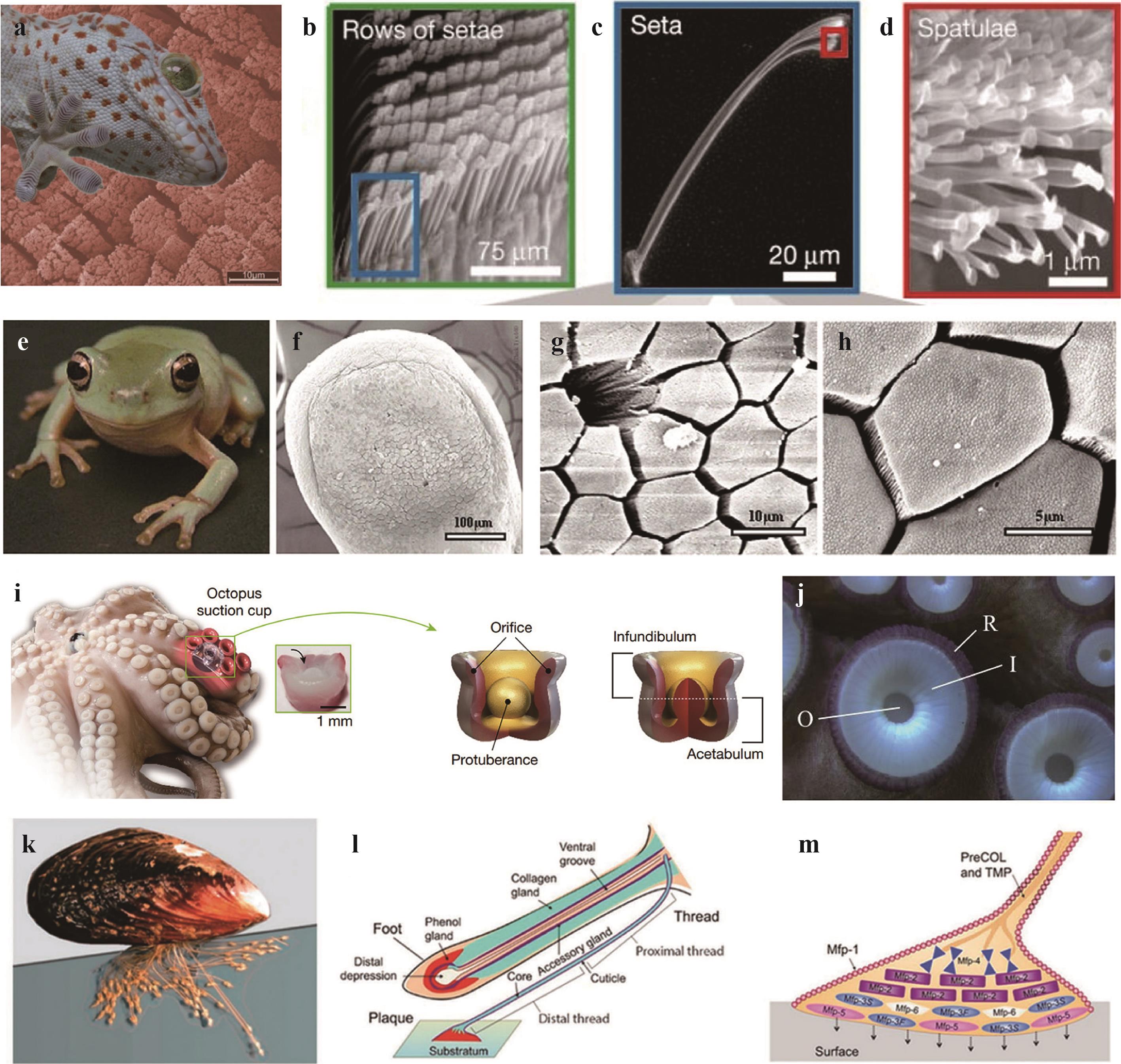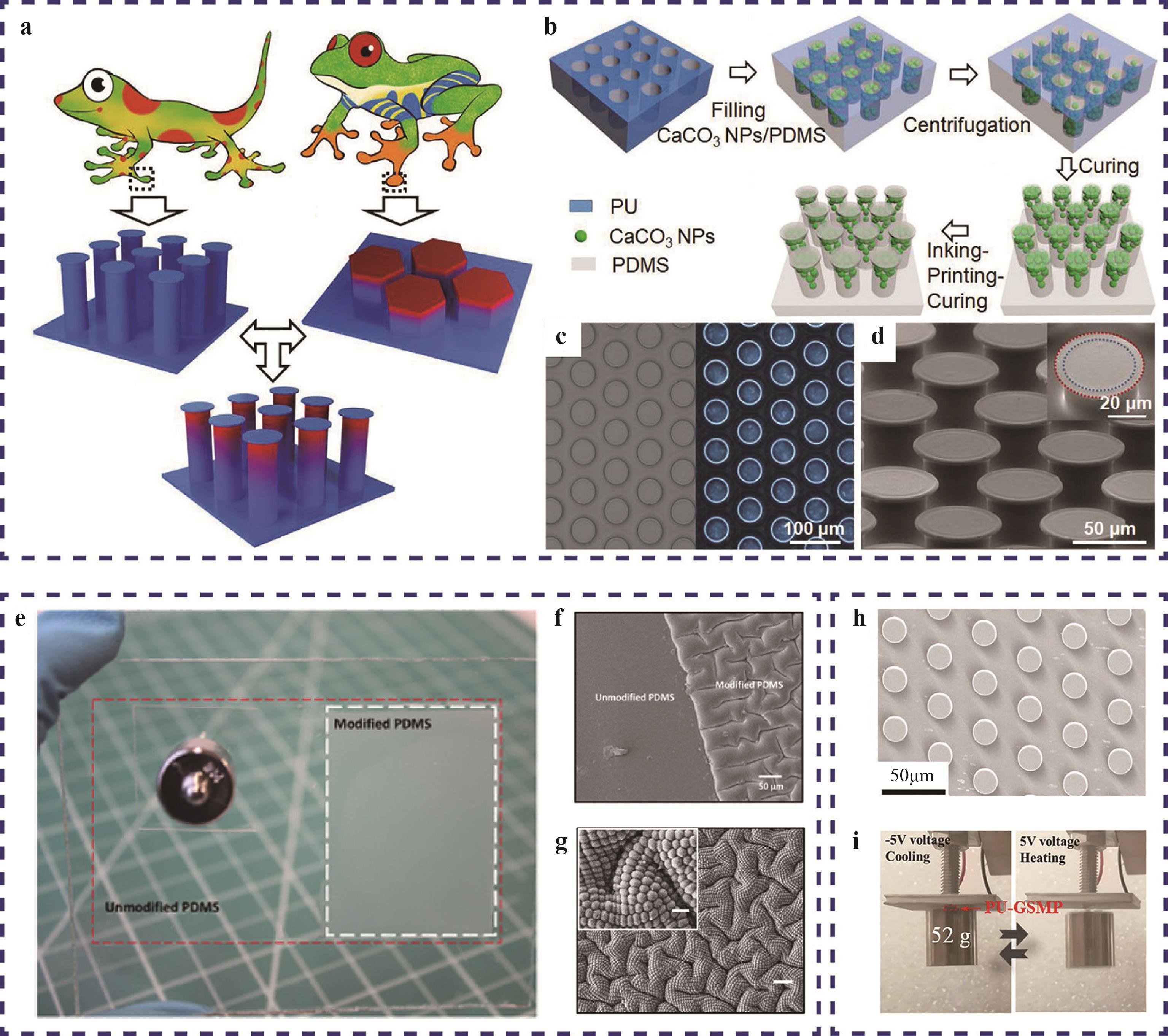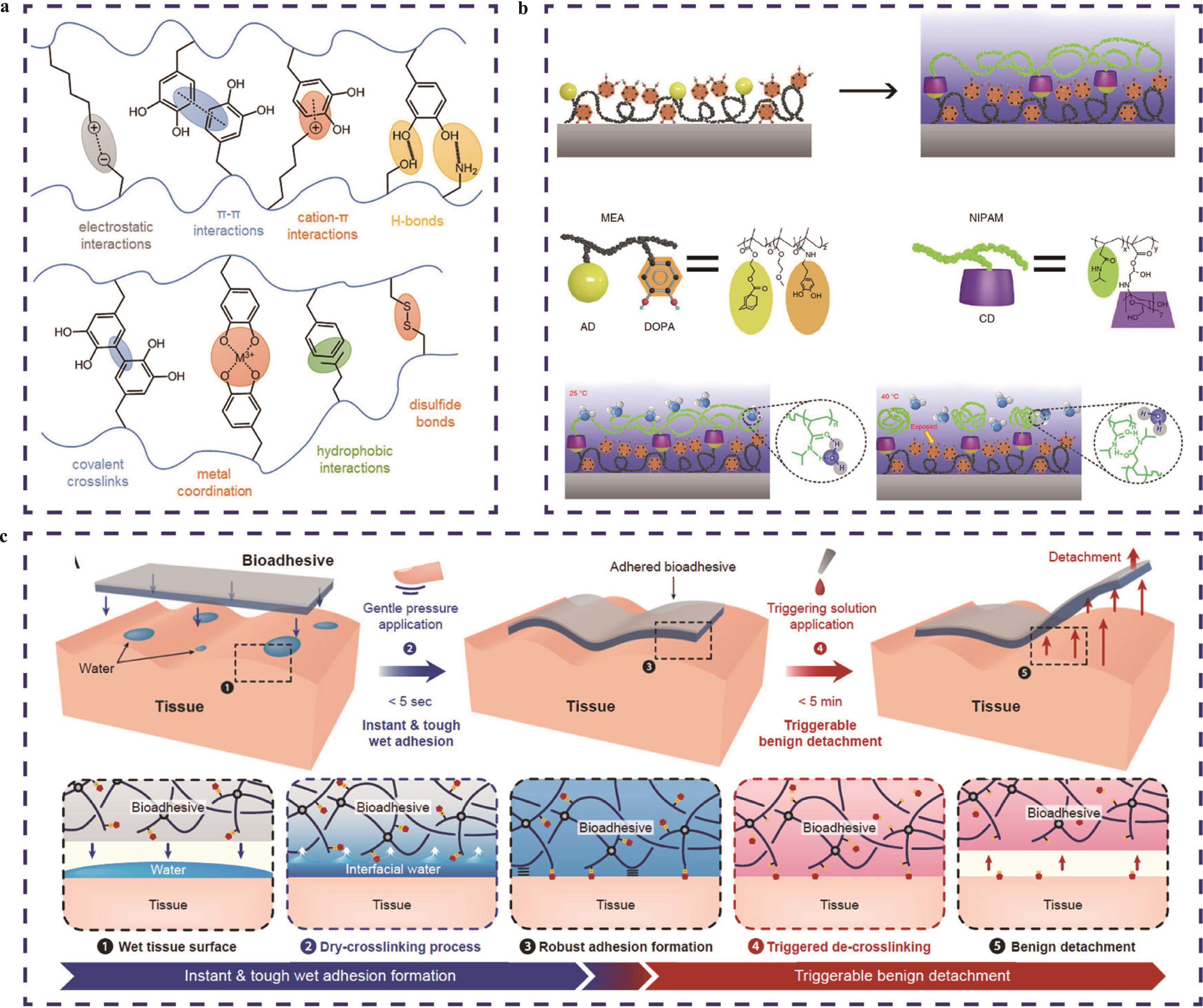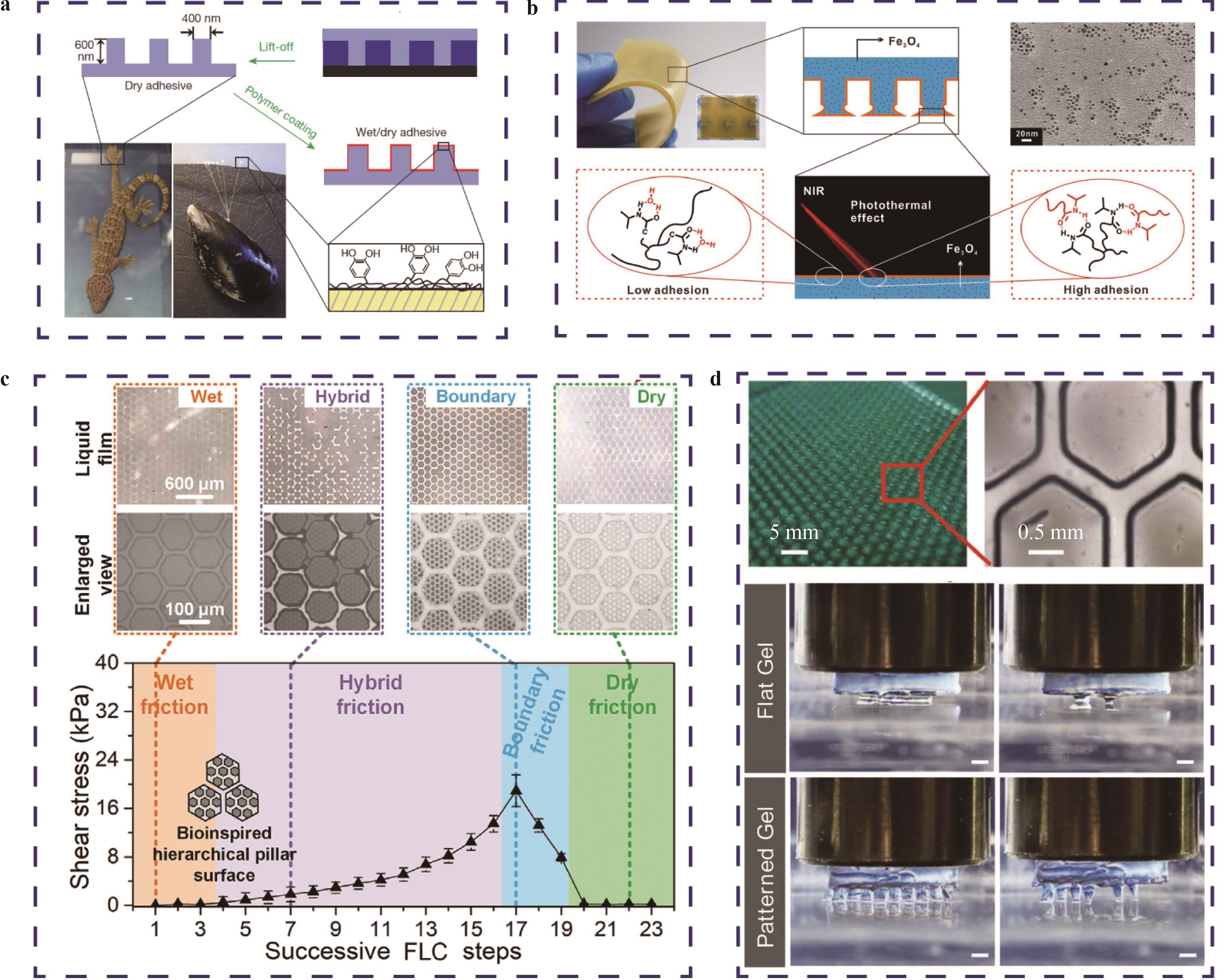
应用化学 ›› 2022, Vol. 39 ›› Issue (1): 86-98.DOI: 10.19894/j.issn.1000-0518.210478
仿生干湿摩擦黏附器件的研究进展
- 1.中国科学院兰州化学物理研究所,固体润滑国家重点实验室,兰州 730000
2.中国科学院大学材料科学与光电技术学院,北京 100049
-
收稿日期:2021-09-26接受日期:2021-10-28出版日期:2022-01-01发布日期:2022-01-10 -
通讯作者:麻拴红,周峰 -
基金资助:中国科学院B类先导科技专项培育项目(XDPB24);国家自然科学基金重点项目(22032006);中国科学院青年创新促进会项目(2019411)
Recent Progress of Biomimetic Dry/Wet Friction Adhesion Devices
ZHANG Yun-Lei1,2,ZHAO Wei-Yi1,2,MA Shuan-Hong1( ),ZHOU Feng1(
),ZHOU Feng1( )
)
- 1.State Key Laboratory of Solid Lubrication,Lanzhou Institute of Chemical Physics,Chinese Academy of Sciences,Lanzhou 730000,China
2.Center of Materials Science and Opto-Electronics Engineering,University of Chinese Academy of Sciences,Beijing 100049,China
-
Received:2021-09-26Accepted:2021-10-28Published:2022-01-01Online:2022-01-10 -
Contact:Shuan-Hong MA,Feng ZHOU -
About author:mashuanhong@licp.cas.cn; zhouf@licp.cas.cn
-
Supported by:the Key Research Program of the Chinese Academy of Sciences(XDPB24);the National Natural Science Foundation of China(22032006);the Youth Innovation Promotion Association(2019411)
摘要:
生物在自然界的演化过程中进化出了许多独特的干湿摩擦、黏附器官来适应其生存环境。研究人员通过对自然界中典型摩擦与黏附现象的研究、认识和总结,提出了相应的仿生界面摩擦、黏附理论与模型,用于指导人工合成型智能摩擦黏附材料与器件。目前,仿生摩擦、黏附材料体系与器件的设计策略主要以表面微结构、界面物理化学相互作用以及机械形变为基础。但是,随着对生物摩擦黏附机理更加深入的了解,多策略耦合的设计理念逐渐成为主要研究方向。在此背景下,围绕表面微结构、界面物理化学修饰改性、机械形变调控的单一设计策略和多种耦合策略4部分,详细综述了近年来有关仿生摩擦黏附材料器件的最新研究进展,并分别针对单个与多策略耦合的设计理念以及其各自的优缺点进行了详细分析,阐述了这些材料与器件的创新设计原理、界面黏附性能、潜在性应用前景以及存在的问题。最后,对仿生摩擦、黏附材料与器件的未来发展方向进行了展望。该综述对表面工程、生物医学、微电子等领域的研究具有一定的指导意义。
中图分类号:
引用本文
张云雷, 赵蔚祎, 麻拴红, 周峰. 仿生干湿摩擦黏附器件的研究进展[J]. 应用化学, 2022, 39(1): 86-98.
ZHANG Yun-Lei, ZHAO Wei-Yi, MA Shuan-Hong, ZHOU Feng. Recent Progress of Biomimetic Dry/Wet Friction Adhesion Devices[J]. Chinese Journal of Applied Chemistry, 2022, 39(1): 86-98.

图1 (a - d)壁虎及其脚趾上的疏水多级分形微纳结构[3, 5]; (e - h)树蛙及其脚掌的亲水六边形结构[12]; (i - j)章鱼及其触手的吸盘结构[14, 21] ; (k - m)贻贝及其足丝蛋白[22]
Fig.1 (a - d) A gecko and the hydrophobic multistage fractal structures on its toes[3,5]; (e - h) A tree frog and the hydrophilic hexagonal structures on its feet pads[12]; (i - j) A octopus and the suckers on its tentacles[14,21]; (k - m) Mussel and its byssus protein[22]

图2 (a)壁虎与树蛙启发的梯度模量结构化表面摩擦黏附器件; (b - d)梯度模量结构化表面PDMS制备过程与形貌[33]; (e - g)蛇皮启发的结构化表面干摩擦器件光学照片与形貌[37]; (h)刺激响聚氨酯结构化表面黏附器件; (i)刺激响应黏附器件的可逆黏附行为演示[38]
Fig.2 (a) A gecko and tree frog inspired gradient modulus structured device for friction and adhesion; (b - d) The preparation process and morphology of gradient modulus structured PDMS[33]; (e - g) Optical photographs and morphology of structured surface of the snakeskin-inspired dry friction device[37]; (h) Stimulus responsive structured polyurethane adhesive. (i) Reversible adhesion behavior of adhesive devices[38]

图3 (a)多巴胺为基础的微观可逆相互作用[18]; (b)主客体识别耦合温度亲疏水响应的可逆黏附策略[19]; (c)界面吸水策略与动态调控策略耦合的可逆黏附策略[53]
Fig.3 (a) Dopamine-based surface and interface interactions[18]; (b) Reversible adhesion strategy based on host-guest interactions and thermal responsive properties[19]; (c) Reversible adhesion strategy based on interface water absorption and dynamic bonding[53]

图4 (a)仿壁虎脚趾的自剥离形状记忆聚合物器件与其贴合、剥离接触状态[58]; (b)热响应液晶为基础的弯曲形变剥离器件以及抓取释放硅片演示[60]; (c)基于Diels-alder反应的自愈合压力驱动抓取器件与抓取物体演示[61]
Fig.4 (a) Attachment and peeling states of the gecko toes inspired self-peeling shape memory polymer devices[58];(b) The grasping and releasing demonstration of the liquid crystal based device[60];(c) The grasping and releasing demonstration of the self-healing pressure driven grasping device based on Diels-Alder reaction[61]

图5 (a)壁虎脚表面微结构耦合本体形变诱导可逆抓取的黏附器件[62]; (b)表面微结构耦合不对称基底曲率的策略实现液滴转移[65]; (c)表面微结构耦合本体机械形变的软体机器人[67]
Fig.5 (a) A reversible adhesion device realized by the combining effect of surface microstructure and mechanical deformation[62]; (b) A droplet transfer device realized by coupling the surface microstructure and asymmetric substrate curvature[65]; (c) Locomotion of smart soft robot achieved by coupling the surface microstructure and mechanical deformation of body[67]

图6 (a)表面微结构耦合界面化学增强水下可逆黏附策略[40]; (b)近红外调控界面浸润性实现水下可逆黏附策略[42]; (c)微结构接触界面间水膜破裂产生的毛细作用用于界面摩擦增强策略[70]; (d)结构化黏性水凝胶器件[76]
Fig.6 (a) An underwater reversible adhesion strategy based on surface microstructure and enhanced by surface chemistry[40]; (b) An underwater reversible adhesion strategy achieved by Near-infrared (NIR) regulation of interface wettability[42]; (c) A friction strengthen strategy achieved by the capillary force generated from water film rupture between microstructural contact interfaces[70]; (d) Structured adhesion hydrogel devices[76]
| 1 | CHEN Y, MENG J, GU Z, et al. Bioinspired multiscale wet adhesive surfaces: structures and controlled adhesion[J]. Adv Funct Mater, 2020, 30(5): 1905287. |
| 2 | ARZT E, QUAN H, MCMEEKING R M, et al. Functional surface microstructures inspired by nature-from adhesion and wetting principles to sustainable new devices[J]. Prog Mater Sci, 2021: 100823. |
| 3 | AUTUMN K, LIANG Y A, HSIEH S T, et al. Adhesive force of a single gecko foot-hair[J]. Nature, 2000, 405(6787): 681-685. |
| 4 | AUTUMN K, SITTI M, LIANG Y C A, et al. Evidence for van der Waals adhesion in gecko setae[J]. PNAS, 2002, 99(19): 12252-12256. |
| 5 | HUBER G, MANTZ H, SPOLENAK R, et al. Evidence for capillarity contributions to gecko adhesion from single spatula nanomechanical measurements[J]. PNAS, 2005, 102(45): 16293-16296. |
| 6 | SONG Y, WANG Z, LI Y, et al. Electrostatic attraction caused by triboelectrification in climbing geckos[J]. Friction, 2020: 1-10. |
| 7 | IZADI H, STEWART K M, PENLIDIS A. Role of contact electrification and electrostatic interactions in gecko adhesion[J]. J R Soc Interface, 2014, 11(98): 20140371. |
| 8 | SINGLA S, JAIN D, ZOLTOWSKI C M, et al. Direct evidence of acid-base interactions in gecko adhesion[J]. Sci Adv, 2021, 7(21): eabd9410. |
| 9 | TIAN Y, PESIKA N, ZENG H, et al. Adhesion and friction in gecko toe attachment and detachment[J]. PNAS, 2006, 103(51): 19320-19325. |
| 10 | HANNA G, JON W, BARNES W J. Adhesion and detachment of the toe pads of tree frogs[J]. J Exp Biol, 1991, 155(1): 103-125. |
| 11 | BARNES W J P. Functional morphology and design constraints of smooth adhesive pads[J]. MRS bulletin, 2007, 32(6): 479-485. |
| 12 | SCHOLZ I, BARNES W J P, SMITH J M, et al. Ultrastructure and physical properties of an adhesive surface, the toe pad epithelium of the tree frog, Litoria caerulea white[J]. J Exp Biol, 2009, 212(2): 155-162. |
| 13 | HANNA G, BARNES W J P. Adhesion and detachment of the toe pads of tree frogs[J]. J Exp Biol, 1991, 155: 103-125. |
| 14 | TRAMACERE F, APPEL E, MAZZOLAI B, et al. Hairy suckers: the surface microstructure and its possible functional significance in the Octopus vulgaris sucker[J]. Beilstein J Nanotechnol, 2014, 5(1): 561-565. |
| 15 | GRECO G, BOSIA F, TRAMACERE F, et al. The role of hairs in the adhesion of octopus suckers: a hierarchical peeling approach[J]. Bioinspiration Biomimetics, 2020, 15(3): 035006. |
| 16 | SAREH S, ALTHOEFER K, LI M, et al. Anchoring like octopus: biologically inspired soft artificial sucker[J]. J R Soc Interface, 2017, 14(135): 20170395. |
| 17 | LI X, TAO D, LU H, et al. Recent developments in gecko-inspired dry adhesive surfaces from fabrication to application[J]. Surf Topogr: Metrol Prop, 2019, 7(2): 023001. |
| 18 | HOFMAN A H, VAN HEES I A, YANG J, et al. Bioinspired underwater adhesives by using the supramolecular toolbox[J]. Adv Mater, 2018, 30(19): 1704640. |
| 19 | ZHAO Y, WU Y, WANG L, et al. Bio-inspired reversible underwater adhesive[J]. Nat Commun, 2017, 8(1): 1-8. |
| 20 | SHINTAKE J, CACUCCIOLO V, FLOREANO D, et al. Soft robotic grippers[J]. Adv Mater, 2018, 30(29): 1707035. |
| 21 | BAIK S, PARK Y, LEE T J, et al. A wet-tolerant adhesive patch inspired by protuberances in suction cups of octopi[J]. Nature, 2017, 546(7658): 396-400. |
| 22 | WAITE J H. Mussel adhesion-essential footwork[J]. J Exp Biol, 2017, 220(4): 517-530. |
| 23 | ARZT E, GORB S, SPOLENAK R. From micro to nano contacts in biological attachment devices[J]. PNAS, 2003, 100(19): 10603-10606. |
| 24 | XIANG T, HOU J, XIE H, et al. Biomimetic micro/nano structures for biomedical applications[J]. Nano Today, 2020, 35: 100980. |
| 25 | HENSEL R, MOH K, ARZT E. Engineering micropatterned dry adhesives: from contact theory to handling applications[J]. Adv Funct Mater, 2018, 28(28): 1800865. |
| 26 | HU H, TIAN H, LI X, et al. Biomimetic mushroom-shaped microfibers for dry adhesives by electrically induced polymer deformation[J]. ACS Appl Mater Interfaces, 2014, 6(16): 14167-14173. |
| 27 | FISCHER S C, GROß K, TORRENTS ABAD O, et al. Funnel-shaped microstructures for strong reversible adhesion[J]. Adv Mater Interfaces, 2017, 4(20): 1700292. |
| 28 | YI H, KANG M, KWAK M K, et al. Simple and reliable fabrication of bioinspired mushroom-shaped micropillars with precisely controlled tip geometries[J]. ACS Appl Mater Interfaces, 2016, 8(34): 22671-22678. |
| 29 | ZHANG X, CHEN G, YU Y, et al. Bioinspired adhesive and antibacterial microneedles for versatile transdermal drug delivery[J]. Research, 2020, 2020: 3672120. |
| 30 | WANG Y, TIAN H, SHAO J, et al. Switchable dry adhesion with step-like micropillars and controllable interfacial contact[J]. ACS Appl Mater Interfaces, 2016, 8(15): 10029-10037. |
| 31 | JIN K, CREMALDI J C, ERICKSON J S, et al. Biomimetic bidirectional switchable adhesive inspired by the gecko[J]. Adv Funct Mater, 2014, 24(5): 574-579. |
| 32 | TAO D, GAO X, LU H, et al. Controllable anisotropic dry adhesion in vacuum: gecko inspired wedged surface fabricated with ultraprecision diamond cutting[J]. Adv Funct Mater, 2017, 27(22): 1606576. |
| 33 | LIU Q, TAN D, MENG F, et al. Adhesion enhancement of micropillar array by combining the adhesive design from gecko and tree frog[J]. Small, 2020: 2005493. |
| 34 | WANG Z. Slanted functional gradient micropillars for optimal bioinspired dry adhesion[J]. ACS Nano, 2018, 12(2): 1273-1284. |
| 35 | HU H, TIAN H, SHAO J, et al. Discretely supported dry adhesive film inspired by biological bending behavior for enhanced performance on a rough surface[J]. ACS Appl Mater Interfaces, 2017, 9(8): 7752-7760. |
| 36 | RAUT H K, BAJI A, HARIRI H H, et al. Gecko-inspired dry adhesive based on micro-nanoscale hierarchical arrays for application in climbing devices[J]. ACS Appl Mater Interfaces, 2018, 10(1): 1288-1296. |
| 37 | WANG M, GHOSH S K, STAFFORD C M, et al. Snakeskin-inspired elastomers with extremely low coefficient of friction under dry conditions[J]. ACS Appl Mater Interfaces, 2020, 12(51): 57450-57460. |
| 38 | TAN D, WANG X, LIU Q, et al. Switchable adhesion of micropillar adhesive on rough surfaces[J]. Small, 2019, 15(50): 1904248. |
| 39 | HU S, LOPEZ S, NIEWIAROWSKI P H, et al. Dynamic self-cleaning in gecko setae via digital hyperextension[J]. J R Soc Interface, 2012, 9(76): 2781-2790. |
| 40 | LEE H, LEE B P, MESSERSMITH P B. A reversible wet/dry adhesive inspired by mussels and geckos[J]. Nature, 2007, 448(7151): 338-341. |
| 41 | CHEN B, SEIDEL S, HORI H, et al. Self-assembly of pillars modified with vapor deposited polymer coatings[J]. ACS Appl Mater Interfaces, 2011, 3(11): 4201-4205. |
| 42 | MA Y, MA S, WU Y, et al. Remote control over underwater dynamic attachment/detachment and locomotion[J]. Adv Mater, 2018, 30(30), 1801595. |
| 43 | ZHANG C, WU B, ZHOU Y, et al. Mussel-inspired hydrogels: from design principles to promising applications[J]. Chem Soc Rev, 2020, 49(11): 3605-3637. |
| 44 | FAN H, GONG J P. Bioinspired underwater adhesives[J]. Adv Mater, 2021: 2102983. |
| 45 | LAMPING S, OTREMBA T, RAVOO B J. Carbohydrate-responsive surface adhesion based on the dynamic covalent chemistry of phenylboronic acid-and catechol-containing polymer brushes[J]. Angew Chem Int Ed, 2018, 57(9): 2474-2478. |
| 46 | WANG Z, GUO L, XIAO H, et al. A reversible underwater glue based on photo-and thermo-responsive dynamic covalent bonds[J]. Mater Horiz, 2020, 7(1): 282-288. |
| 47 | YANG B, LIM C, HWANG D S, et al. Switch of surface adhesion to cohesion by dopa-Fe3+ complexation, in response to microenvironment at the mussel plaque/substrate interface[J]. Chem Mater, 2016, 28(21): 7982- 7989. |
| 48 | XIE T, DING J, HAN X, et al. Wound dressing change facilitated by spraying zinc ions[J]. Mater Horiz, 2020, 7(2): 605-614. |
| 49 | AHN Y, JANG Y, SELVAPALAM N, et al. Supramolecular velcro for reversible underwater adhesion[J]. Angew Chem Int Ed, 2013, 52(11): 3140-3144. |
| 50 | ZHAO Q, LEE D W, AHN B K, et al. Underwater contact adhesion and microarchitecture in polyelectrolyte complexes actuated by solvent exchange[J]. Nat Mater, 2016, 15(4): 407-412. |
| 51 | NARKAR A R, BARKER B, CLISCH M, et al. pH responsive and oxidation resistant wet adhesive based on reversible catechol-boronate complexation[J]. Chem Mater, 2016, 28(15): 5432-5439. |
| 52 | YUK H, VARELA C E, NABZDYK C S, et al. Dry double-sided tape for adhesion of wet tissues and devices[J]. Nature, 2019, 575(7781): 169-174. |
| 53 | CHEN X, YUK H, WU J, et al. Instant tough bioadhesive with triggerable benign detachment[J]. PNAS, 2020, 117(27): 15497-15503. |
| 54 | MIN H, JANG S, KIM D W, et al. Highly air/water-permeable hierarchical mesh architectures for stretchable underwater electronic skin patches[J]. ACS Appl Mater Interfaces, 2020, 12(12): 14425-14432. |
| 55 | BAKER L B, MODEL J B, BARNES K A, et al. Skin-interfaced microfluidic system with personalized sweating rate and sweat chloride analytics for sports science applications[J]. Sci Adv, 2020, 6(50): eabe3929. |
| 56 | WU Y, PEI X, WANG X, et al. Biomimicking lubrication superior to fish skin using responsive hydrogels[J]. NPG Asia Mater, 2014, 6(10): e136-e136. |
| 57 | RONG M, LIU H, SCARAGGI M, et al. High lubricity meets load capacity: cartilage mimicking bilayer structure by brushing up stiff hydrogels from subsurface[J]. Adv Funct Mater, 2020, 30(39): 2004062. |
| 58 | XIE T, XIAO X. Self-peeling reversible dry adhesive system[J]. Chem Mater, 2008, 20(9): 2866-2868. |
| 59 | ZHANG Y, MA S, LI B, et al. Gecko’s feet-inspired self-peeling switchable dry/wet adhesive[J]. Chem Mater, 2021, 33(8): 2785-2795. |
| 60 | SHAHSAVAN H, SALILI S M, JáKLI A, et al. Thermally active liquid crystal network gripper mimicking the self-peeling of gecko toe pads[J]. Adv Mater, 2017, 29(3): 1604021. |
| 61 | TERRYN S, BRANCART J, LEFEBER D, et al. Self-healing soft pneumatic robots[J]. Sci Robot, 2017, 2(9): 1-12. |
| 62 | KIZILKAN E, STRUEBEN J, STAUBITZ A, et al. Bioinspired photocontrollable microstructured transport device[J]. Sci Robot, 2017, 2(2), eaak9454. |
| 63 | KIZILKAN E, GORB S N. Combined effect of the microstructure and underlying surface curvature on the performance of biomimetic adhesives[J]. Adv Mater, 2018, 30(19): 1704696. |
| 64 | TIAN H, LIU H, SHAO J, et al. An electrically active gecko-effect soft gripper under a low voltage by mimicking gecko's adhesive structures and toe muscles[J]. Soft Matter, 2020, 16(24): 5599-5608. |
| 65 | LIIMATAINEN V, DROTLEF D M, SON D, et al. Liquid-superrepellent bioinspired fibrillar adhesives[J]. Adv Mater, 2020, 32(19):2000497. |
| 66 | BAIK S, HWANG G W, JANG S, et al. Bioinspired microsphere-embedded adhesive architectures for an electrothermally actuating transport device of dry/wet pliable surfaces[J]. ACS Appl Mater Interfaces, 2021, 13(5): 6930-6940. |
| 67 | WANG X, YANG B, TAN D, et al. Bioinspired footed soft robot with unidirectional all-terrain mobility[J]. Mater Today, 2020, 35: 42-49. |
| 68 | LI Q, LI L, SHI K, et al. Reversible structure engineering of bioinspired anisotropic surface for droplet recognition and transportation[J]. Adv Sci, 2020: 2001650. |
| 69 | MA L, GAISINSKAYA-KIPNIS A, KAMPF N, et al. Origins of hydration lubrication[J]. Nat Commun, 2015, 6(1): 1-6. |
| 70 | ZHANG L, CHEN H, GUO Y, et al. Micro⁃nano hierarchical structure enhanced strong wet friction surface inspired by tree frogs[J]. Adv Sci, 2020: 2001125. |
| 71 | PENG Y, SERFASS C M, KAWAZOE A, et al. Elastohydrodynamic friction of robotic and human fingers on soft micropatterned substrates[J]. Nat Mater, 2021: 1-5. |
| 72 | YUK H, ZHANG T, PARADA G A, et al. Skin-inspired hydrogel-elastomer hybrids with robust interfaces and functional microstructures[J]. Nat Commun, 2016, 7(1): 1-11. |
| 73 | YU Y, YUK H, PARADA G A, et al. Multifunctional “hydrogel skins” on diverse polymers with arbitrary shapes[J]. Adv Mater, 2019, 31(7): 1807101. |
| 74 | BAIK S, KIM J, LEE H J, et al. Highly adaptable and biocompatible octopus-like adhesive patches with meniscus-controlled unfoldable 3D microtips for underwater surface and hairy skin[J]. Adv Sci, 2018, 5(8): 1800100. |
| 75 | KIM D W, BAIK S, MIN H, et al. Highly permeable skin patch with conductive hierarchical architectures inspired by amphibians and octopi for omnidirectionally enhanced wet adhesion[J]. Adv Funct Mater, 2019, 29(13): 1807614. |
| 76 | RAO P, SUN T L, CHEN L, et al. Tough hydrogels with fast, strong, and reversible underwater adhesion based on a multiscale design[J]. Adv Mater, 2018, 30(32): 1801884. |
| 77 | YI H, LEE S H, SEONG M, et al. Bioinspired reversible hydrogel adhesives for wet and underwater surfaces[J]. J Mater Chem B, 2018, 6(48): 8064-8070. |
| 78 | LIU H, ZHAO X, ZHANG Y, et al. Cartilage mimics adaptive lubrication[J]. ACS Appl Mater Interfaces, 2020, 12(45): 51114-51121. |
| [1] | 陈建兵, 王武生, 王宇, 曾俊, 王爱东. 聚含氟丙烯酸酯-聚氨酯三嵌段共聚物水基分散体的合成及膜结构[J]. 应用化学, 2006, 23(2): 198-202. |
| [2] | 郝冬梅, 柴子晓, 王新灵, 唐小真. 环氧树脂/反应性聚碳酸酯/叔胺体系的表面结构与性能[J]. 应用化学, 2005, 22(8): 904-907. |
| [3] | 林德娟, 沈水发, 陈耐生, 黄金陵. 纳米半导体材料SO2-4/La-α-Fe2O3的表面结构与酒敏特性[J]. 应用化学, 2002, 19(10): 972-975. |
| [4] | 张瑞峰, 于亚莉, 刘学恕, 姚耀广. 等离子体改性的聚偏氟乙烯表面结构的XPS研究[J]. 应用化学, 1992, 0(6): 42-45. |
| [5] | 周茂堂, 王世才, 陈捷. 辉光放电处理聚四氟乙烯——Ⅲ.PTFE表面结构的XPS表征[J]. 应用化学, 1990, 0(6): 82-84. |
| 阅读次数 | ||||||
|
全文 |
|
|||||
|
摘要 |
|
|||||